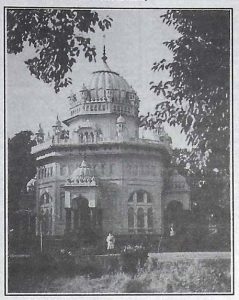
[By: Satyindra Singh]
September 12, 1897 is a day that needs to be recalled with intense pride, not only by the Indian Army but for the whole Sikh nation. But sadly, one dis covers that whilst this battle of epic dimensions is taught to children in France, and is one of the stories of collective bravery published by UNESCO it finds at peripheral mention in our history volumes for our children and future generations to draw sustenance from. A foreign journal has mentioned that Saraghari is one of the five most significant events of its kind in the world beginning from the saga of Thermopylae associated with the heroic stand by a small Greek force against the mighty Persian army led by Xerxes in 480 B.C. The name of Thermopylae has passed into the history of mankind and has inspired heroism of every kind and a name which will indeed ever by associated with self-sacrifice. Saraghari epitomizes self-sacrifice by a very small band of our own Sikh sol die rarely a century ago. Lt. General Harbaksh Singh, a distinguished soldier of yester year, who has done the nation proud in the War of 1965, and been a colonel of this regi loaned the author some records and journals in which there is invaluable material on the Saraghari saga and the author has drawn sustenance from these and some other records, including the volume, “Saraghari Battalion from Ashes to Glory”! In one of these journals is recorded the Saraghari speech by the former President Zakir Hussain (then Governor of Bihar) delivered at the Sikh Regimental Center, Ranchi on Sept.12, 1961. As Dr. Zakir Hussain said on the occasion: “The mind travels back to the day, 64 years ago, this day in 1897. On this fateful on a rugged, inhospitable of the. Forbidding terrain, a brave little band of 21 Sikhs stood its ground steadfastly to the utter last, in the midst of a swarming sea of hostile assail ants, and bore unmistakable witness to the gallantry and honor of the Indian Army. It is an episode that we remember today but it is nonetheless an historic event in the annals of our Army, rich with lessons of unsurpassed gallantry, self-effacing loyalty and unconditional allegiance to the call of duty over 20,000 in number, who had been repulsed a few days earlier from Fort Gulistan, surrounded the little piquet post at Saraghari, thus severing Fort Gulistan from Fort Lockhart. No aid could be sent to the isolated piquet. The brave band of Sikhs in the piquet post put up a heroic fight. Very small in number, and with but limited ammunition, they kept the ever swelling hordes at bay most of the day, inflicting heavy losses on them. The brave little band of 21 Sikhs soldiers, under Havildar Ishar Singh, fell or were mortally wounded. Only Gurmukh Singh the signaler, was still alive. Cool and collected in this moment of imminent danger, face to face with certain death, this gallant soldier, with utter dedication to his duty, which was his worship, signaled to Fort Lockhart: “The enemy are in. Shall I go on signal ling or shall I take a rifle?” He did take his rifle, and after the rest had been killed, he alone continued to de fend the guardroom and shot 20 of the enemy. The enemy set the place on fire, and the bodies of the 21 gallant Sikhs (including an equally gallant safai Karamchari, as also Havildar Ishar Singh, dead or dying were consumed in the flames. Yes, their bodies, but not their souls were set upon fire. Are these heroes really dead? No, they live on, more alive than any of us, they live in our hearts and urge us on to heroism and gallantry.”
When the news of the battle was flashed to London, the British Parliament rose to give a standing ovation when the story was related to a packed and emotion filled house. All the 21 brave heroes were awarded the Indian Order of Merit (IOM) posthumously. The award of 22 1OM in one day, the highest gallantry award given to the Indian ranks those days, and equivalent to Victoria Cross (Param Vir Chakra) was something unheard of and remains unparalleled in the annals of militancy history. There are many lessons to be learned. Firstly, see how these heroes were honored and how or potbellied and scam stained politicians honor our gallant he toes in the present the comparison is starkly revealing and shocking. Secondly, this great battle and supreme sacrifice of these brave Sikhs need to find a place in our history volumes. Thirdly, some of our national leaders should annually participate in honoring them. There is much more awareness required at the national level of such great and now forgotten events. Finally, of the two shrines (historical gurdwaras at Amritsar and Ferozpur) to commemorate the gallantry of these 22 immortals, the one at Amritsar deserves greater attention and sanctity, like the one in Ferozpur. The Amritsar shrine is surrounded by dhabas and shops and other encroachments. The one at Ferozpur, which is looked after by the Sikh Regiment, is appropriately honored. Let the ‘managers’ of the Amritsar shrine also hand this Memorial over to the Sikh Regiment.
Article extracted from this publication >> September 11, 1996